A lot of non-designers tend to assume that a graphic designer’s job is easy. Anyone can come up with a logo or design a flyer, right? Heck, someone’s nephew (who likes to draw since he was five and the only artist in the family!) can supposedly get the job done in a couple of hours.
But is it that simple really?
While pursuing creative freedom and getting paid at the same time is one of the perks of being a graphic designer, the job itself is far from merely coming up with landing pages, logos, infographics, fonts, or even flyers.
To thrive (and not just survive!) as a graphic designer these days, you should also be willing to embrace skills that are usually outside of a typical designer’s skill set. These non-design skills include understanding the psychology behind a specific design, persuading clients of your design ideas, and handling criticism like a champ. Plus you have to keep yourself up to date with relevant trends in your industry.
Whether you’re a student who’s thinking about dabbling in graphic design once you get out of school or you’re already in your 30s and would love to switch careers, look no further for the ultimate guide on how to become a graphic designer.
As a good jumping-off point for anyone interested in learning more about the ins and outs of becoming a graphic designer, this guide is divided into three sections:
- Understanding Graphic Design – You can’t be great at graphic design unless you have a clear-cut understanding of what it does and what graphic designers are supposed to accomplish.
- Learning Graphic Design – Learn about the top graphic design books to read, online courses and tutorials that are worth every penny, and where to find graphic design inspiration when you need a little nudge to get going.
- Graphic Design Careers and Salary – Understand what graphic designers really do at work, find out what a day in the life of a graphic designer in 2017 (because what graphic designers did five years ago may have changed) is like, and bust the myth of the starving artist.
If you’re already a graphic designer yourself, we also encourage you to share your helpful thoughts and suggestions for industry newbies in the comments below.
What Is Graphic Design?
“Design is not just about how an object looks and feels like. Design is how it works.”
We didn’t make this quote out of thin air because Steve Jobs did. If you’ve been trying to get your foot in the door of the graphic design industry, understanding this important distinction is crucial. By doing so, you’ll be able to set yourself apart from the nephew who can supposedly finish a logo in five minutes.
Steve Jobs fandom aside, what is graphic design really?
For the most legit graphic design definition out there, the Professional Association for Design has this to say:
“Also known as communication design, graphic design is the art and practice of planning and projecting ideas and experiences with visual and textual content. The form of communication can be physical or virtual and may include images, words, or graphic forms. The experience can take place in an instant or over a long period of time. The work can happen at any scale, from the design of a single postage stamp to a national postal signage system, or from a company’s digital avatar to the sprawling and interlinked digital and physical content of an international newspaper. It can also be for any purpose, whether commercial, educational, cultural, or political.”
And if you’re in the mood for some philosophical musings, author Adrian Shaughnessy writes in his book, How to Be a Graphic Designer Without Losing Your Soul:
“Among the myriad definitions of graphic design, one of the most illuminating is by American designer and writer Jessica Helfand. According to Helfand, graphic design is a visual language uniting harmony and balance, color and light, scale and tension, form and content. But it is also an idiomatic language, a language of cues and puns and symbols and allusions, of cultural references and perceptual inferences that challenge both the intellect and the eye.”
Shaughnessy further explains:
“The second part of Helfand’s definition provides the key to producing meaningful and expressive graphic design: ‘cues and puns and symbols and allusions, of cultural references and perceptual inferences’, are the elements that give work authority and resonance. And if you want to introduce these elements into your work, it means taking an interest in everything that goes on around you and having a curiosity about areas other than graphic design: politics, entertainment, business, technology, art, ten-pin bowling, and mud wrestling.”
With these definitions in mind, it looks like the wonderful folks at Treefrog were right when they described graphic design as art with a purpose.
At this point, we can safely say that graphic designers combine images, shapes, textures, lines, colors, and text to convey a message.
Learn Graphic Design Without Losing Your Mind
The barrage of online resources out there promising that you’ll be a graphic designer in x number of days can be quite overwhelming for newbies and amateurs alike. Not to mention that graphic design is a broad, diverse discipline which can further throw you off balance.
As you endlessly cull the interwebs and bookmark sites, you’ll likely get frustrated with the lack of progress or direction. Nine times out of ten, this frustration will likely stop you from pursuing your graphic design education altogether.
So what now?
Take a break from the information overload and reflect on the specific graphic design concepts that interest you. Afterward, decide to focus on a specific set of resources to guide you as you continue your graphic design studies.
Depending on your specific interest in graphic design, the following resources are wonderful starting points that will guide you toward graphic design proficiency.
Graphic Design Books
This is not a list of 10, 20, or even 50 graphic design books to check out. After all, the goal is to have a basic understanding of the field and subsequently decide on a graphic design specialty. We’ll start with five books on the subject that are chock-full of practical (not just abstract!) insights.
The Vignelli Canon by Massimo Vignelli
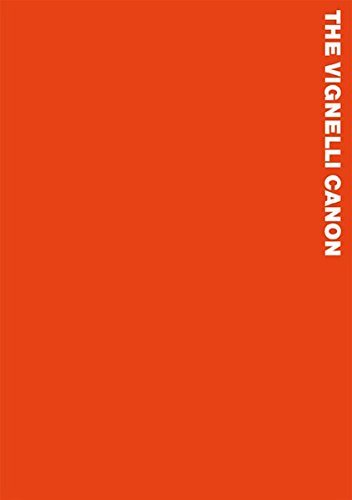
Considered as one of the greatest 20th-century designers, Massimo Vignelli wrote about his fundamental design principles in this short yet concise book on modernist design aesthetics. Vignelli has made it available as a free PDF download.
Above the Fold: Understanding the Principles of Successful Web Site Design by Brian D. Miller
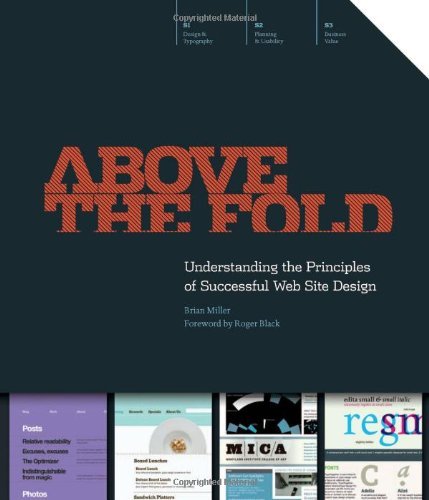
If you’d like to delve into web design as your graphic design specialty, Above the Fold, should be on your desk. The book is divided into three distinct areas: Design & Typography, Planning & Usability, and Business Value. All three are involved in a typical web design project these days.
Thinking With Type by Ellen Lupton
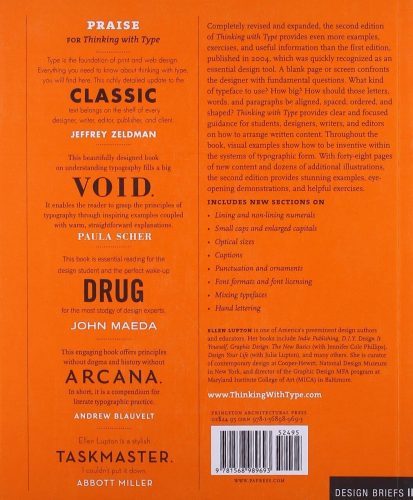
Thinking With Type is the perfect reference book for anyone who wants to uncover the role of type design in visual communication. This book features different images of type designed in various ways and accompanying texts explaining various principles of typography. If you intend to add this book to your graphic design library, get the revised edition.
Making and Breaking the Grid by Timothy Samara
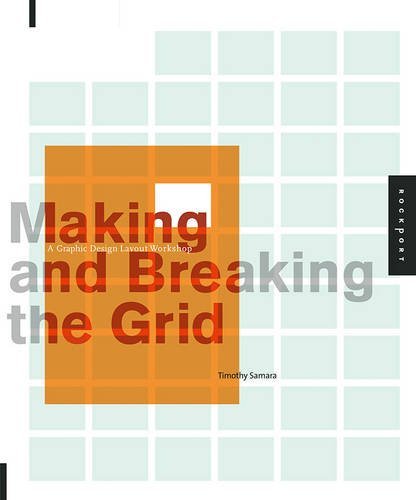
This is a nifty reference book to help begin your foray into layout and design. Timothy Samara’s approach in Making and Breaking the Grid is ideal if you’re the type who learns best by studying the work of other designers instead of going through step-by-step instructions.
Design is a Job by Mike Monteiro

Let go of the starving artist stereotype and learn from Mike Monteiro’s punchy, to-the-point advice on how to make a living as a designer in Design is a Job.
Additional Recommended Reading:
You Can Draw in 30 Days: The Fun, Easy Way to Learn to Draw in One Month or Less (Mark Kistler)
The Elements of Graphic Design (Alex W. White)
Picture This: How Pictures Work (Molly Bang)
Don’t Make Me Think: A Common Sense Approach to Usability (Steve Krug)
The Design of Everyday Things (Don Norman)
Graphic Design Courses
If you’re currently pressed for time and/or funds to enroll in a graphic design course at an attendance-based college or university, online graphic design courses are flexible, affordable alternatives. Some online courses are free while you may have to shell out fees for others.
Regardless of the course (paid or not) you’re keen about, keep in mind that learning is a lifelong process. For starters, hop on to the following sites for comprehensive yet easy-to-follow graphic design tutorials and learning guides:
Hack Design
Hack Design describes themselves as an online resource where the world’s best designers help curate the best and most useful blogs, books, games, videos, and tutorials that helped them learn critical elements of design when they were also starting out. Check out their Know Your Tools lessons for a start.
Tuts+ Design and Illustration Guides
Tuts+ started out as a blog but eventually expanded into an educational learning library for developers and designers. Their text guides and video-based tutorials on graphic design will help polish your practical design skills such as mastering logo design in Adobe Illustrator or how to master Sketch.
Lynda.Com’s Graphic Design Courses
With over 1,000 courses, Lynda.com’s popular graphic design topics include latest tips and tricks on Photoshop, Illustrator, InDesign, and SketchBook Pro. The site also runs courses on how to run your design business.
Udemy’s Graphic Design Courses
As one of the top online learning marketplaces today, Udemy makes it easier for members to learn graphic design concepts because they’re mostly available anytime and on any device. At Udemy, you can master graphic design concepts through their Graphic Design Bootcamp Course, Ultimate Photoshop Training, and more.
Academy of Art University
Since 2002, the Academy has taught online graphic design courses and their program is considered one of the most advanced online design programs available. The majority of their graduates end up working for Silicon Valley’s tech giants.
Recommended additional options for self-learning graphic design include learning portals like CreativeLive, SkillShare, and Kelby One.
Graphic Design Inspiration
After plowing through graphic design books and mastering your design tools through online tutorials, building your portfolio should be next on your list.
To help you quickly get over the dreaded design slump and finish your portfolio, check out these cozy corners on the Internet for instant graphic design inspiration.
Online learning resource from Tilda website builder. Practical guides to web design and digital marketing and two complete courses on Landing Page and No-Code Animation.
You will never run out of creative ideas and visual inspiration once you find your way to Swiss Miss, a design blog with lots of links pointing to equally inspiring sites. The blog is the brainchild of Tina Roth Eisenberg, a Swiss designer in New York who also founded and runs CreativeMornings, Tattly, and TeuxDeux.
The folks at Say What Studio, a graphic design duo based in Paris, France, came up with Mirador as a way to curate and highlight their favorite design pieces and creative work.
Good Design Makes Me Happy started in 2009 as an inspiration journal by graphic designer Hannah Dollery. Eight years later (and counting!), the blog has become a daily read for many designers and non-designers alike.
Websites like Dribbble, Behance, ArtStation, DeviantArt, and other places where designers can show off their work are also awe-inspiring for the graphic designer lacking in #designspiration.
Kickstarting Your Graphic Design Career
Graphic design careers vary because the field itself is broad and diverse too. There’s web design, hand lettering, logo design, and a lot more sub-specialties. As a result, you’ll be working with a wide range of clientele and projects. For many veteran graphic designers, it’s not uncommon to have a varied portfolio and an ever-changing client list.
Before taking the plunge into graphic design, it pays to be aware of the specific roles and responsibilities expected of a graphic designer — whether it’s working with a team as the resident designer or by offering graphic design services as a solopreneur/freelancer.
In this final section, we’ll explore the typical graphic designer job description, required skills, salary range, and related jobs.
What Does a Graphic Designer Do
So what does a graphic designer do?
The short answer is graphic designers are visual communicators, and copywriters are language communicators.
If you want a more detailed description of the typical graphic designer job description, you’ll likely get mixed responses because graphic designers can take on a few different paths in their careers. For instance, take a peek at these short videos illustrating the creative process of three graphic designers:
Bree, a Textile Graphic Designer
Will, a Logo Designer
Now that you’ve witnessed how varied a graphic designer’s roles and responsibilities can be, the next logical question is: What one skill do all three designers have in common?
Problem-solving.
You may have noticed that the designers in the videos didn’t create their nifty work because they merely wanted to. Through the creative brief, they were asked to solve a problem or pursue a specific outcome.
Simply put, graphic designers create and ship designs that are rooted in strategy. Often, the success of their design has nothing to do with the number of people who are wowed by their aesthetics, but rather whether or not they have accomplished a project or campaign’s goals.
Graphic Design Specialties
While being a generalist or a specialist has its own set of pros and cons, the best (and well-paid!) designers out there tend to have T-shaped skills. The T-shape designer has a depth of skill and experience in one discipline, as represented by the vertical stroke, while also having breadth via skills and experience across other disciplines, as represented by the horizontal stroke.
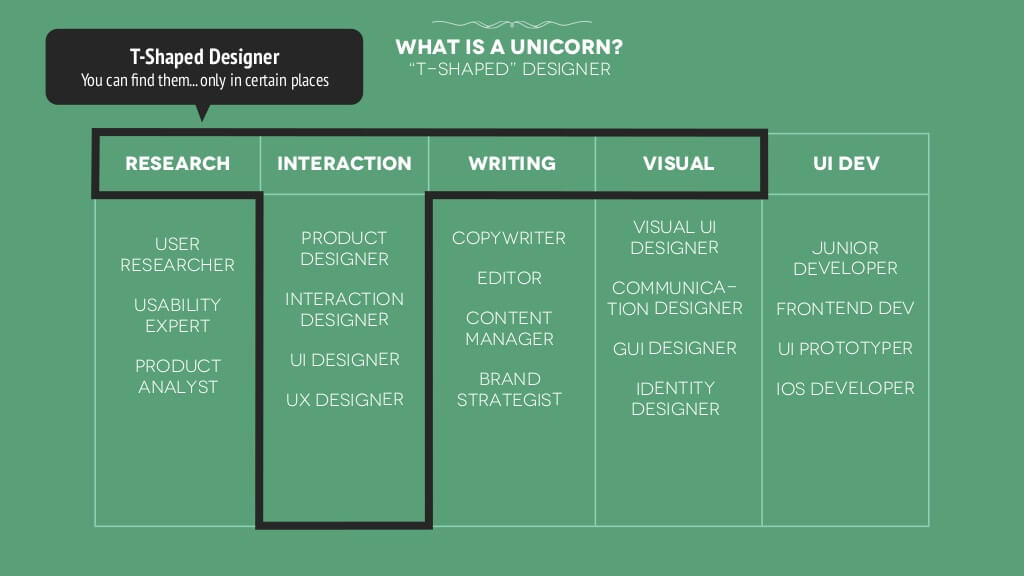
Image credit: Lab80
After getting yourself acquainted with foundational knowledge of graphic design concepts and tools, you might be thinking about specializing. Graphic design specialties range from traditional practices like print design to the agile nature of digital design.
To help you get started, here’s a quick rundown of the main areas in graphic design that you can explore:
- Animation
- App Design
- Book and Publishing Design
- Brand and Logo Design
- Illustration
- Marketing and Advertising Design
- Packaging Design
- Print Design combining traditional and digital technology
- Typography and Type Design
- Web Design
Besides thinking about a specific graphic design area that you want to delve into, you might also want to consider the type of organization or company that you want to work for/with. You can choose among startups or early-stage companies, mid-sized/large organizations, agencies, studios, and consultancies. As you gain more experience, you can also opt to start your own design business.
In hindsight, figuring out your specialty as a graphic designer takes a lot of practice, self-awareness, and learning (or unlearning).
Graphic Designer Job Description
Like most creative jobs, being a great graphic designer isn’t just about how adept you are in using specific software. Nor it has to do with your legendary drawing skills.
Sure, a solid and wide-ranging portfolio will make you stand out, but it’s merely half the story. Besides technical mastery, your soft skills (Seth Godin encourages everyone to stop referring to ‘em as soft skills and he has a point!) matter too. Empathy, grit (for those times when you’ve got multiple deadlines!), conflict management, and professionalism are some examples of these so-called soft skills.
Today, it’s not uncommon to have two totally different job descriptions with varied graphic designer responsibilities and requirements. The following graphic designer job descriptions illustrate how diverse a graphic designer’s role can be.
Here’s one from OnTrac, an IT solutions company in the UK, who are looking for a graphic design intern:
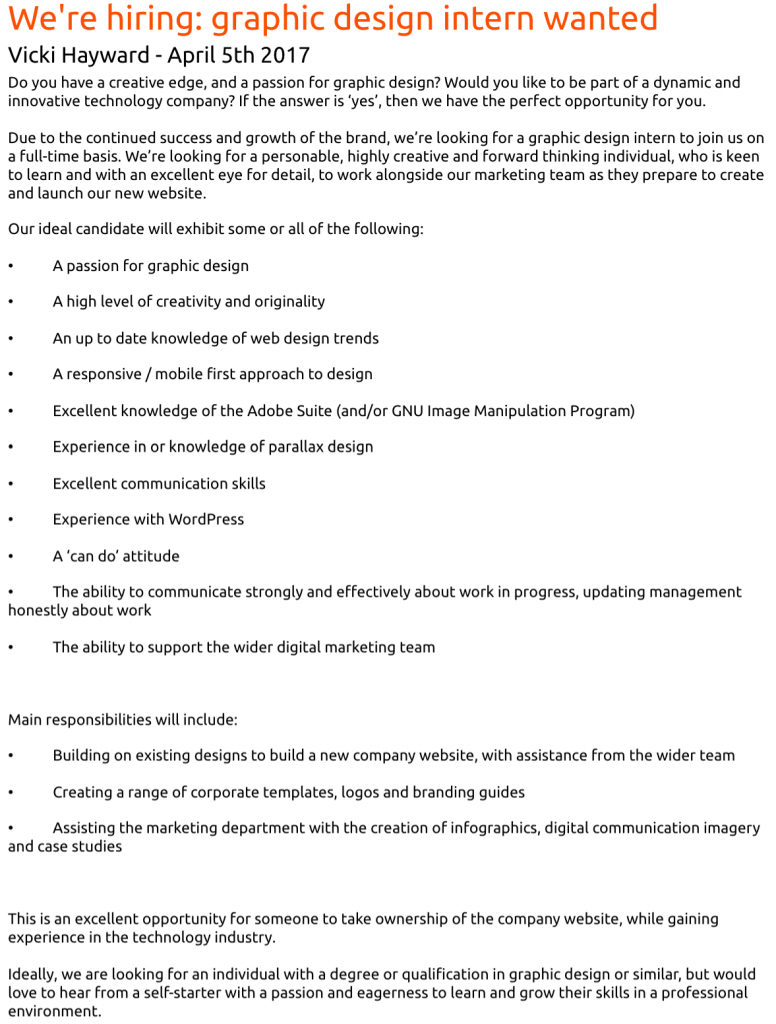
Meanwhile, here’s what Facebook is looking for in a graphic designer:
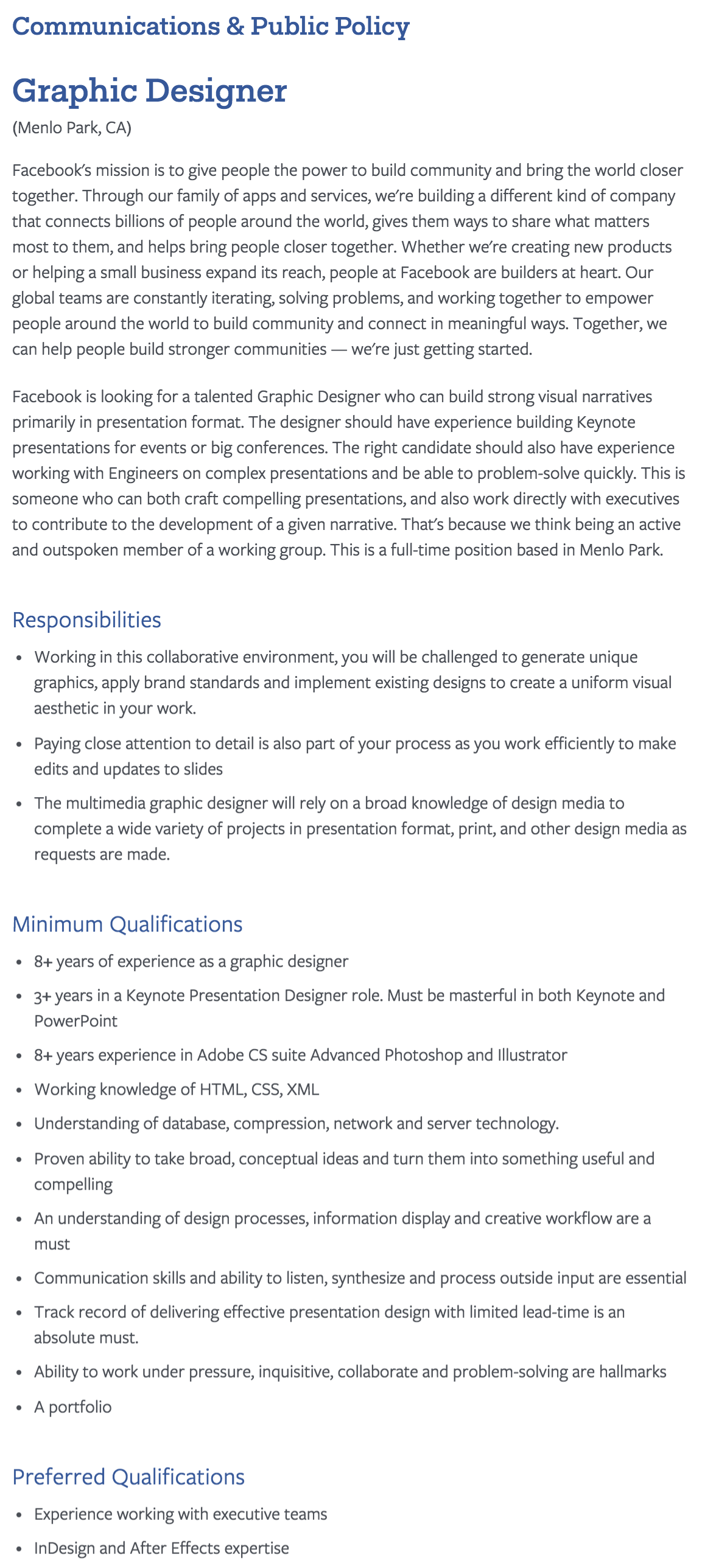
Finally, Velocity Partners, a B2B marketing agency is seeking a senior graphic designer who has the following design superpowers:
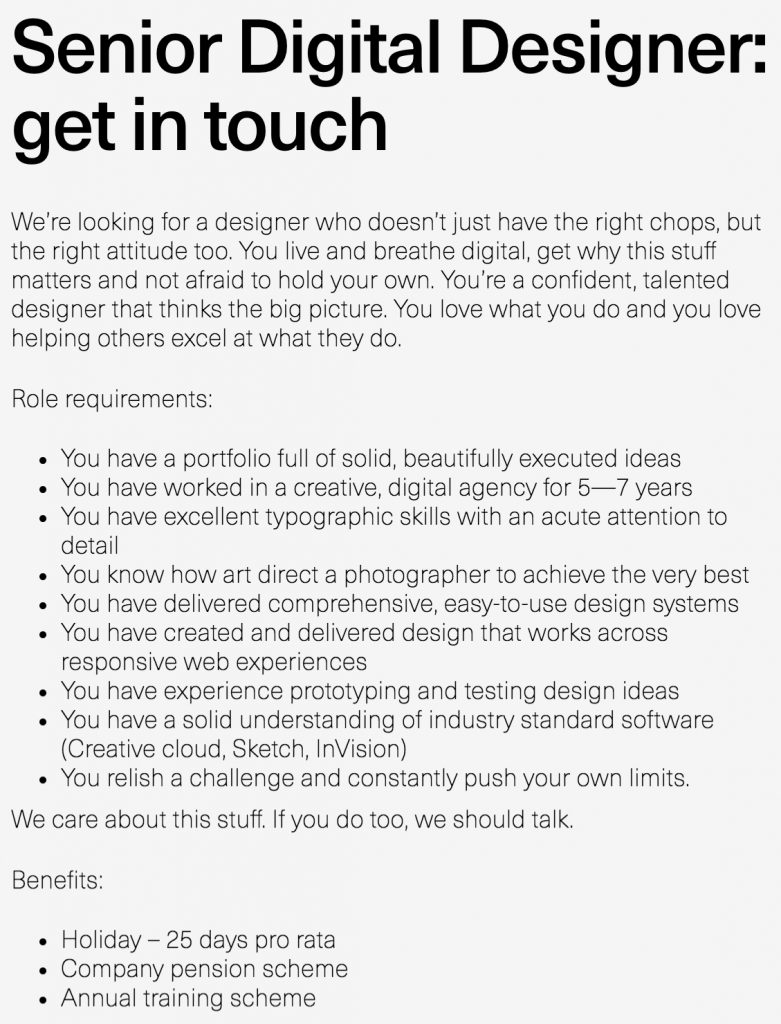
Graphic Designer Salary
Before we dive deeper into the subject of graphic designer salaries, keep in mind that average graphic designer salaries you see online should be treated as rough rules of thumb. Why?
First, salaries vary depending on a designer’s geographical location Second, no two graphic design jobs are alike. The Invision’s Kayleigh Karutis writes, the word “designer” today means quite a bit more than it did even just a few years ago.
Speaking of InVision, the company commissioned a third-party organization in 2015 to analyze their survey of more than 1,650 designers from 65 countries for their 2016 Product Design Report.
Here’s a snapshot of the report describing average designer salaries:
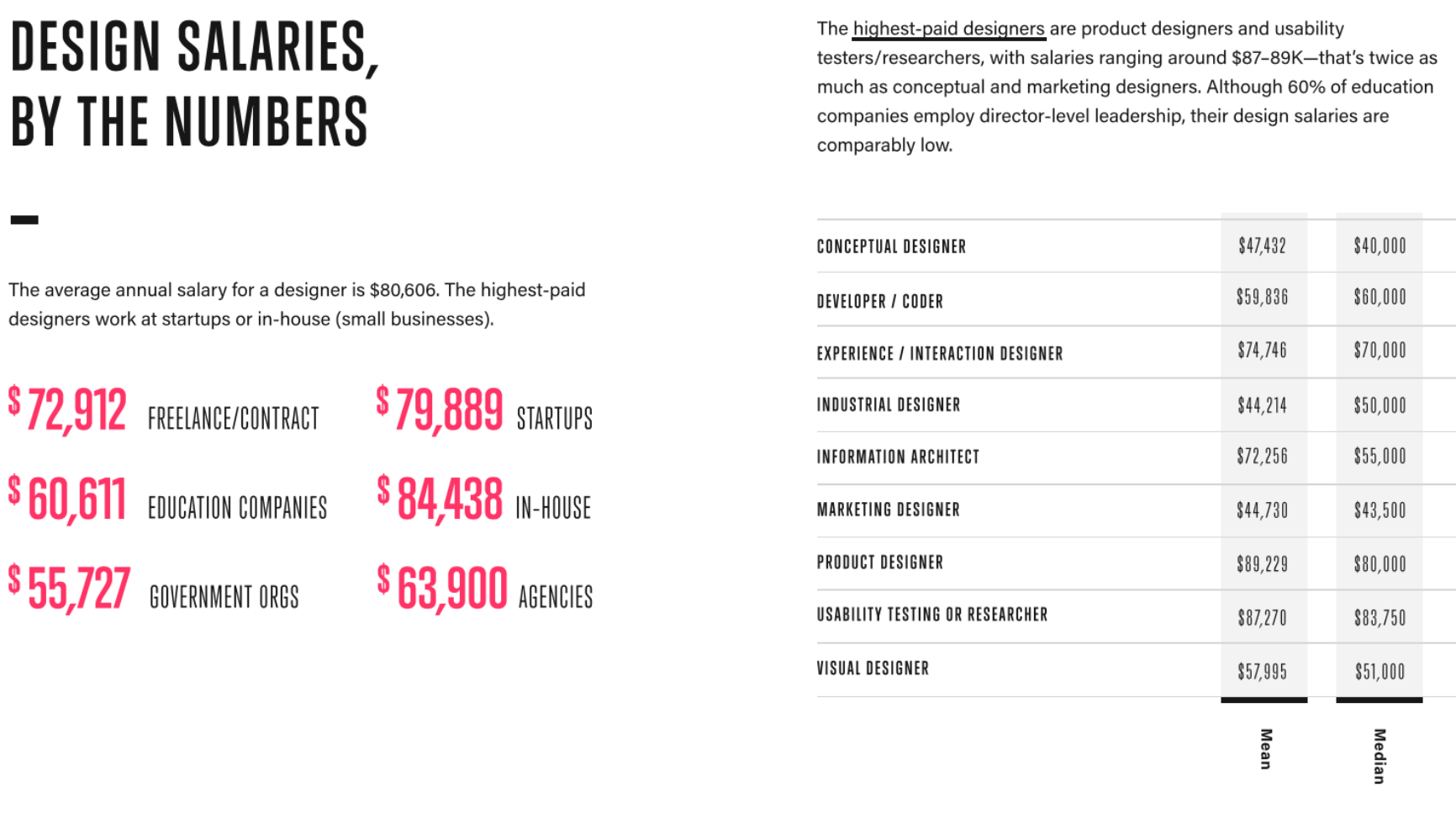
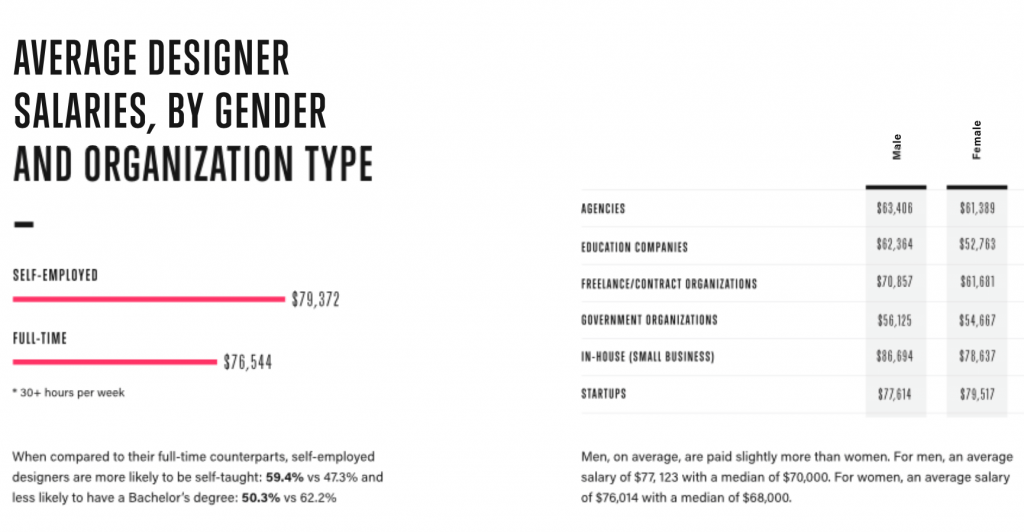
In the report, the job titles marketing designer and conceptual designer are the ones closest to what a graphic designer typically does. For this group, the average salary is $47,000-49,000 per year.
Meanwhile, the 2017 Salary Center for Creative and Marketing Professionals by The Creative Group came up with the following findings:
- Junior graphic designer salary (1-3 years): $39,750–$56,750
- Senior graphic designer salary (5+ years): $67,500–$93,000
- Package designer salary: $59,500–$91,000
- Visual designer salary: $66,000–$99,250
- Front-end web developer (3+ years) salary: $80,000–$119,500
- Web designer (5+ years): $83,250–$118,000
- Interaction designer (5+ years): $88,250–$124,500
- UX designer (1–3 years): $52,000–$79,500
- UX designer (5+ years): $92,750–$138,000
Never Stop Learning
Just like any other creative professional, you have to adapt to the newest industry trends in order to make a living as a graphic designer these days. You have to learn new skills, techniques, and tools as you wear multiple hats. You may be designing infographics today but you might be handling a small team by next month as your company expands. Perhaps, the tools you’re using right now might turn out obsolete in the next three years.
Whatever graphic design specialty or niche you’re considering, lifelong learning should be a career priority because the design industry is constantly evolving. The sheer amount of resources — time, funds, or FOMO-ing while your friends are out partying the whole night — associated with learning graphic design may intimidate or discourage you at first. Yet keep in mind that the best graphic designers out there were once newbies like you too. Start working on your graphic designer portfolio today!

About the author: Kyjean Tomboc is a freelance UX writer and copywriter with over five years of experience working with design, healthcare, and technology companies. Her background and (sometimes unhealthy) interest in storytelling, language, design thinking, and user research make up her UX writing toolkit.
Read how to become a UX designer, get a simple checklist for icon design, and review the basics of visual storytelling